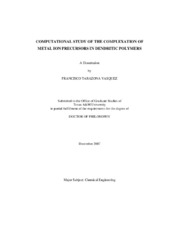| dc.description.abstract | Metal ions are important for medical, environmental and catalytic applications. They are
used as precursor molecules for the manufacture of metal nanocatalysts, which are
promising materials for an array of biomedical, industrial, and technological
applications.
Understanding the effect of the environment upon a metal ion-dendrimer system
constitutes a step closer to the understanding of the liquid phase templated synthesis of
metal nanoparticles. In this dissertation we have used computational techniques such as
abinitio calculations and molecular dynamics (MD) simulations to investigate the
complexation of Cu(II) and Pt(II) metal ions to a polyamidoamine (PAMAM) dendritic
polymer from structural, thermodynamic, and kinetic viewpoints.
First, we analyze the local configuration of a low generation polyamidoamine
dendrimer to understand the role of intramolecular interactions. Then, we examine the
local configuration of dendrimer outer pockets in order to determine their capacity to
encapsulate water within. Next, the complexation of Cu(II) with a small –OH terminated
dendrimer in presence of solvent and counterions is investigated. This relatively simple
system gives insight on how cationic species bind within a dendrimer.
The complexation of potassium tetrachloroplatinate, commonly used precursor salt
in dendrimer templated synthesis of platinum and bimetallic platinum-containing
nanoparticles, with PAMAM dendrimer has been the subject of several experimental
reports. So we investigate the complexation of potassium tetrachloroplatinate within a
dendrimer outer pocket in order to understand the effect of dendrimer branches, Pt(II)
speciation, pH, solvent and counterions upon it. Our study shows that dendrimer branches can improve the thermodynamics but can also preclude the kinetics by raising
the energy barriers. Our study provides an explanation of why, where Pt(II) and how
Pt(II) binds. We believe that these molecular level details, unaccessible to experimental
techniques, can be a helpful contribution toward furthering our understanding of the
complexation of Pt(II) and the starting point to study the next step of dendrimer
templated synthesis, the reduction of Pt(II) into platinum nanoparticles inside pockets. | en |


